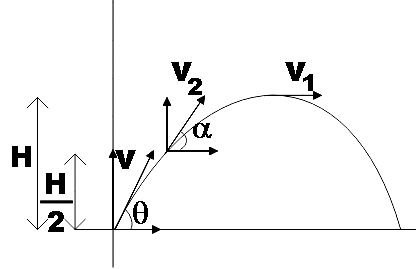
The speed of a projectile at its highest point is ${{v}_{1}}$ and at the point half the maximum height is ${{v}_{2}}$. If $\dfrac{{{v}_{1}}}{{{v}_{2}}}=\sqrt{\dfrac{2}{5}}$ then find the angle of projection.
A. $45{}^\circ $
B. $30{}^\circ $
C. $37{}^\circ $
D.$60{}^\circ $
Answer
541.2k+ views
Hint: As a first step, you could make a rough diagram of the projectile motion under discussion. Then, you could consider the motion part by part. You could apply Newton’s equation of motion for the case of motion from 0 to H and H to$\dfrac{H}{2}$ separately. Now using those relations along with the given conditions we will get the angle of the projectile.
Formula used:
Equation of motion,
${{v}^{2}}-{{u}^{2}}=2as$
Complete answer:
In the question, we are given the speed of a projectile at the highest point as ${{v}_{1}}$ and at the point that is half the maximum height be${{v}_{2}}$. We are given that,
$\dfrac{{{v}_{1}}}{{{v}_{2}}}=\sqrt{\dfrac{2}{5}}$…………………………………………. (1)
We are supposed to find the angle of projection.

We know that at the highest point the vertical component of velocity is zero. Also, for a projectile motion, the horizontal component of velocity remains the same, that is,
$v\cos \theta ={{v}_{2}}\cos \alpha ={{v}_{1}}$
$\Rightarrow \dfrac{{{v}_{1}}}{{{v}_{2}}}=\cos \alpha =\sqrt{\dfrac{2}{5}}$ ………………………………………. (2)
Now, we could consider the motion from$\dfrac{H}{2}$ to $H$,
Let us recall the Newton’s equation of motion,
${{v}^{2}}-{{u}^{2}}=2as$
$\Rightarrow {{v}_{1y}}^{2}-{{v}_{2y}}^{2}=2{{a}_{y}}s$
$\Rightarrow 0-\left( {{v}_{2}}^{2}{{\sin }^{2}}\alpha \right)=2\left( -g \right)\dfrac{H}{2}$
$\Rightarrow {{v}_{2}}^{2}\left( 1-{{\cos }^{2}}\alpha \right)=gH$
From (2),
$\Rightarrow {{v}_{2}}^{2}\left( 1-\dfrac{2}{5} \right)=gH$
$\therefore {{v}_{2}}=\sqrt{\dfrac{5}{3}}gH$ ……………………………………….. (3)
Now from (1),
$\dfrac{{{v}_{1}}}{{{v}_{2}}}=\sqrt{\dfrac{2}{5}}$
$\Rightarrow {{v}_{1}}={{v}_{2}}\times \sqrt{\dfrac{2}{5}}$
$\Rightarrow {{v}_{1}}=\sqrt{\dfrac{5}{3}}gH\times \sqrt{\dfrac{2}{5}}$
$\therefore {{v}_{1}}=\sqrt{\dfrac{2}{3}}gH$
Similarly, for the motion from 0 to H, we have,
${{v}_{{{1}_{y}}}}^{2}-{{\left( v\sin \theta \right)}^{2}}=2\left( -g \right)H$
$\Rightarrow {{v}^{2}}{{\sin }^{2}}\theta =2gH$
$\Rightarrow \dfrac{{{v}_{1}}^{2}}{{{\cos }^{2}}\theta }{{\sin }^{2}}\theta =2gH$
$\dfrac{2}{3}gH{{\tan }^{2}}\theta =2gH$
$\Rightarrow {{\tan }^{2}}\theta =3$
$\Rightarrow \tan \theta =\sqrt{3}$
$\therefore \theta =60{}^\circ $
Therefore, we found that the angle of the projectile in the given question is found to be $60{}^\circ $ .
Hence, option D is found to be the correct answer.
Note:
We have assigned negative signs for the acceleration of the projectile, because we have chosen the convention in such a way. For questions like this you could consider the motion related to each point mentioned in the question. Doing so, you will easily solve the problem and also avoid confusions.
Formula used:
Equation of motion,
${{v}^{2}}-{{u}^{2}}=2as$
Complete answer:
In the question, we are given the speed of a projectile at the highest point as ${{v}_{1}}$ and at the point that is half the maximum height be${{v}_{2}}$. We are given that,
$\dfrac{{{v}_{1}}}{{{v}_{2}}}=\sqrt{\dfrac{2}{5}}$…………………………………………. (1)
We are supposed to find the angle of projection.

We know that at the highest point the vertical component of velocity is zero. Also, for a projectile motion, the horizontal component of velocity remains the same, that is,
$v\cos \theta ={{v}_{2}}\cos \alpha ={{v}_{1}}$
$\Rightarrow \dfrac{{{v}_{1}}}{{{v}_{2}}}=\cos \alpha =\sqrt{\dfrac{2}{5}}$ ………………………………………. (2)
Now, we could consider the motion from$\dfrac{H}{2}$ to $H$,
Let us recall the Newton’s equation of motion,
${{v}^{2}}-{{u}^{2}}=2as$
$\Rightarrow {{v}_{1y}}^{2}-{{v}_{2y}}^{2}=2{{a}_{y}}s$
$\Rightarrow 0-\left( {{v}_{2}}^{2}{{\sin }^{2}}\alpha \right)=2\left( -g \right)\dfrac{H}{2}$
$\Rightarrow {{v}_{2}}^{2}\left( 1-{{\cos }^{2}}\alpha \right)=gH$
From (2),
$\Rightarrow {{v}_{2}}^{2}\left( 1-\dfrac{2}{5} \right)=gH$
$\therefore {{v}_{2}}=\sqrt{\dfrac{5}{3}}gH$ ……………………………………….. (3)
Now from (1),
$\dfrac{{{v}_{1}}}{{{v}_{2}}}=\sqrt{\dfrac{2}{5}}$
$\Rightarrow {{v}_{1}}={{v}_{2}}\times \sqrt{\dfrac{2}{5}}$
$\Rightarrow {{v}_{1}}=\sqrt{\dfrac{5}{3}}gH\times \sqrt{\dfrac{2}{5}}$
$\therefore {{v}_{1}}=\sqrt{\dfrac{2}{3}}gH$
Similarly, for the motion from 0 to H, we have,
${{v}_{{{1}_{y}}}}^{2}-{{\left( v\sin \theta \right)}^{2}}=2\left( -g \right)H$
$\Rightarrow {{v}^{2}}{{\sin }^{2}}\theta =2gH$
$\Rightarrow \dfrac{{{v}_{1}}^{2}}{{{\cos }^{2}}\theta }{{\sin }^{2}}\theta =2gH$
$\dfrac{2}{3}gH{{\tan }^{2}}\theta =2gH$
$\Rightarrow {{\tan }^{2}}\theta =3$
$\Rightarrow \tan \theta =\sqrt{3}$
$\therefore \theta =60{}^\circ $
Therefore, we found that the angle of the projectile in the given question is found to be $60{}^\circ $ .
Hence, option D is found to be the correct answer.
Note:
We have assigned negative signs for the acceleration of the projectile, because we have chosen the convention in such a way. For questions like this you could consider the motion related to each point mentioned in the question. Doing so, you will easily solve the problem and also avoid confusions.
Recently Updated Pages
Master Class 11 Economics: Engaging Questions & Answers for Success

Master Class 11 English: Engaging Questions & Answers for Success

Master Class 11 Social Science: Engaging Questions & Answers for Success

Master Class 11 Biology: Engaging Questions & Answers for Success

Class 11 Question and Answer - Your Ultimate Solutions Guide

Master Class 11 Business Studies: Engaging Questions & Answers for Success

Trending doubts
10 examples of friction in our daily life

One Metric ton is equal to kg A 10000 B 1000 C 100 class 11 physics CBSE

Difference Between Prokaryotic Cells and Eukaryotic Cells

1 Quintal is equal to a 110 kg b 10 kg c 100kg d 1000 class 11 physics CBSE

Explain zero factorial class 11 maths CBSE

What is a periderm How does periderm formation take class 11 biology CBSE




